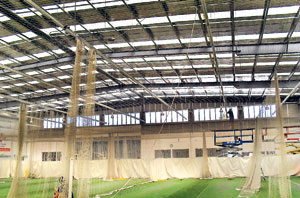|
In turbulent seas, guiding the ship right on course is a risky business. Peril looks on like a bad dream at your face, but once you take over the responsibility a good captain will always be the last to go down with the ship.
In the early 1970s Graham Neil Yallop had just got into the team and yet was a green horn, when the lot of a of the seniors that included the Chappell brothers, the Lillie-Thomson combination etc, abandoned ship and decided to join the Packer Circus forcing the authorities to call upon this young top order batsman of eight Tests to seek the country’s fortunes against England in the next Ashes series. England under Mike Brearley was one of the strongest in the international arena.

Then Victoria centre for excellence in Cricket where Yallop is the Director. |
In the ensuing six Test series played at home, Yallop’s boys lost the Ashes 5-1, but came to win the limited overs series, but, another Test lost to Pakistan soon afterwards saw him relinquishing his captaincy to Kim Hughes. Yet, Yallop was very much a part of the Australian out for almost another
decade and left the side just before his under study Allan Border transformed the team into this cricketing machine that has ruled the world for the past three decades.
The Sunday Musings caught up with this gentle left hander who is the Director of the Victoria Cricket School and the Centre of Excellence of the Monash University, Victoria who had just returned from a visit to Sri Lanka, where he took a batch of Junior cricketers across. As Yallop described “This is the biggest such indoor cricket facility in the Southern Hemisphere” – I being there believed every word he said because it was simply gigantic. With about twenty wickets spread across, one can just imagine the intensity when the facility is in full operation.

Graham Yallop |
First we asked him about his formative years in Test Cricket and what were his feelings when he was forced to take over – just like that – he said “The Majority of the senior pack went with Packer to play in the World Series and the few of us who remained were new to Test cricket. The guys who were left with us included – Graeme Wood, Rick Darling, Kim Hughes and Alan Border etc…we all lacked Test match experience and I who was the most experienced with eight Tests was invited to captain.”
Then Yallop explained that they were to take on Mike Brearley’s English team who were one of the best in the World at that time. “We knew that we were going to be up against it right from the start. Though the reality was that we were not going to lie low and let them run over. We kept on Challenging them right along the series and won one and then beat them in the limited overs games and then took on Pakistan. Though we won the limited overs version we found out that they had too much depth and we were no match in the longer version of it. May be we could have held on for three days, we could not hold on for five.”
Yallop then explained how the turn around—“After two years the side was amalgamated and we started growing by the eighties. It was a gradual affair.”
We then asked as to how they manage to keep their game at a very high level in a very consistent manner. After retirement of McGrath and Warne along with a few others, there was a slight dip, but now it seems that that Australia has bounced back with a bunch of new faces. Yallop answered “It has a lot to do with the infrastructure. Along with facilities like this which are provided to them they can play cricket all round the year, like in Sri Lanka and India. But, the difference is that here the base is very strong. It starts from a very young age. From the base level to club level here the game is very strong. Then the first class comes with state cricket. The standard of cricket is so strong in the state sides I feel that any of Australia’s state sides can give a good run to any of the bottom run Test playing nations.”
Then he explained what he observed in Sri Lanka. He said that in Sri Lanka the standard of school cricket was very high and perhaps the best in the World. But, from that point onwards there was a drop in the standards. Yallop does not believe the standard of club cricket in Sri Lanka has reached the level of a true first class grid to Test requirements. “There is a huge jump in from School cricket to Test cricket. What occurs in Australia is that from the junior levels they graduate into the club levels without a break and here too the standards are very high.
Then from Club cricket they graduate to the State level where first class cricket begins and generally that is the point where the cricketer is considered for national status.”
He then explained that all this is possible because the Cricket Australia adopts the well designed Pathway programme in all states in the same intensity and the standards almost level at all states and this makes the whole Australian cricket base very strong.
However the former Australian skipper is sad because the Australian School Cricket system is not strong. He said that a school may have good cricketers, but they do not play against each other on a regular basis and so any good cricketers at school level do not get the opportunity of blossoming out. Joining a club at junior level is a direct result of this situation in Australia. “In Sri Lanka we see a few schools playing against each other all the time and cricket played at that intensity at that level makes Sri Lanka school cricket strong. I rate Sri Lanka School Cricket probably the best in the World, I ironically the story changes from that point onwards”. Yallop said in conclusion.
|




